Mechanical Properties and Microstructure of Heat-Free Alloys
On this page
2.1 As-cast Tensile Mechanical Properties
2.1.1 AI-Si Series Heat-Free Aluminum Alloys
The research on heat-free aluminum alloy initially targeted the mechanical properties of AISi10MnMg-T7, with a tensile strength of 180MPa, a yield strength of 120MPa, and an elongation of 10%. In the AI-Si series heat-free alloy test, based on the mechanical properties of die-cast flat plates, the materials generally performed well, with tensile strengths of 230–280MPa and yield strengths of 110–140MPa. Except for a few low-Si and low-Mg series, such as the C611 alloy, the yield strength of most alloys can exceed the benchmark value of 120MPa. Regarding elongation, although the performance of different flat plates and casting processes varies, they generally meet the minimum requirement of 10%. Even under optimized conditions, AISi10MnMg alloys can exhibit an elongation greater than 10%. In the research stages, both at the material and test piece levels, the average elongation of heat-free alloys was maintained in the range of 12–16%, while the elongation of some cast test pieces exceeded 17%. However, in actual product sampling, although the strength is not significantly different from that of the flat test piece, the elongation is usually lower than the results from the flat test. In terms of material composition, the key factors affecting the mechanical properties of heat-free alloys include the contents of Si, Mg, and Cu, which play significant roles in regulating the strength and elongation of the alloy. Based on differences in Si content, AI-Si alloys can be divided into two types: low-Si AISi7 and high-Si AISi9. A typical representative of the AISi7 series is the C611 alloy, which has a relatively simple composition and is characterized by high elongation. Table 3 shows the mechanical properties of the C611 flat sample published on the official website of Alcoa, highlighting its excellent elongation.
Based on the AISi10MnMg alloy, the Si and Mg contents were reduced, and trace amounts of V and Zr elements were added. Two grades, HT11 and HT22, were designed to represent two heat-free materials, one with Mg and one without. Die casting and sampling tests were carried out on a self-designed 210 mm x 200 mm plate and compared with C611 and traditional AISi10MnMg alloys, as shown in Table 4. It can be seen that appropriately reducing the Mg content to below 0.3% is a key factor in ensuring elongation. Compared with traditional AISi10MnMg, the HT11 and HT22 grades show significant advantages in elongation, mainly due to the reduction of Si and Mg contents and the precise control of trace strengthening elements.
In the field of heat-free aluminum alloys containing Cu, Xiaomi’s "Titan" alloy stands out for its unique properties. The 0.2% Cu content in the alloy can significantly increase its yield strength to 130–150MPa, while the corresponding elongation is reduced to 11%–13%. During the actual die-casting production process, the material's elongation will further decrease. Therefore, if the product has stringent elongation requirements, such as in self-piercing riveting (SPR) or other processes, the addition of Cu should be minimized during alloy preparation to ensure that the alloy meets the necessary elongation requirements.
Table 4 Properties of AISi9 series alloy and C611 or AISil0MnMg heat-free alloy
Based on the AISi10MnMg alloy, the Si and Mg contents were reduced, and trace amounts of V and Zr elements were added. Two grades, HT11 and HT22, were designed to represent two heat-free materials, one with Mg and one without. Die casting and sampling tests were carried out on a self-designed 210 mm x 200 mm plate and compared with C611 and traditional AISi10MnMg alloys, as shown in Table 4. It can be seen that appropriately reducing the Mg content to below 0.3% is a key factor in ensuring elongation. Compared with traditional AISi10MnMg, the HT11 and HT22 grades show significant advantages in elongation, mainly due to the reduction of Si and Mg contents and the precise control of trace strengthening elements.
In the field of heat-free aluminum alloys containing Cu, Xiaomi’s "Titan" alloy stands out for its unique properties. The 0.2% Cu content in the alloy can significantly increase its yield strength to 130–150MPa, while the corresponding elongation is reduced to 11%–13%. During the actual die-casting production process, the material's elongation will further decrease. Therefore, if the product has stringent elongation requirements, such as in self-piercing riveting (SPR) or other processes, the addition of Cu should be minimized during alloy preparation to ensure that the alloy meets the necessary elongation requirements.
Table 4 Properties of AISi9 series alloy and C611 or AISil0MnMg heat-free alloy
| Composition Series | Material Grade | Yield Strength (MPa) | Tensile Strength (MPa) | Elongation (%) |
| AlSi7 (Mg 0.2%) | C611 | 123.91 | 268.83 | 14.68 |
| AlSi9 (without Mg) | HT11 | 118.18 | 257.69 | 15.52 |
| AlSi9 (Mg 0.2%) | HT22 | 132.23 | 272.42 | 13.45 |
| AlSi10 (Mg 0.4%) | AISi10MnMg | 150.83 | 301.85 | 10.02 |
2.1.2 Ai-Mg Series Heat-Free Aluminum Alloy
As a typical Al-Mg alloy, Magsimal-59 alloy has clear advantages in as-cast mechanical properties compared to Al-Si alloys, as shown in Table 5. However, pure Al-Mg alloys have a high tendency for hot cracking during die casting due to their wide solidification temperature range, which limits their application in die casting production. Typically, an appropriate amount of Si is added to Al-Mg alloys to effectively improve their casting stability and die casting adaptability.
Table 5 Mechanical properties of as-cast Magsimal-59 alloy
Zuqi Hu and others studied the mechanical properties of the Magsimal-59 alloy in high-vacuum die casting. The tensile strength of the alloy was 320 MPa, the yield strength was 189MPa, the elongation was 8.31%, and the hardness (HBW) was 95. The JDA2b alloy developed by Shanghai Jiaotong University has a yield strength of 180–220MPa and an elongation of 8%–12% in the cast state, reaching the T6 state level of AISi10MnMg. Therefore, products using JDA2b die casting can save on the heat treatment costs of conventional high-performance die-cast aluminum alloys, such as T6/T7, and the subsequent component correction costs.
Table 5 Mechanical properties of as-cast Magsimal-59 alloy
| Thickness (mm) | Yield Strength (MPa) | Tensile Strength (MPa) | Elongation (%) |
| < 2 | > 220 | > 300 | 10 - 15 |
| [2, 4) | 160 - 220 | 310 - 340 | 12 - 18 |
| [4, 6) | 140 - 170 | 250 - 320 | 9 - 14 |
| [6, 12) | 120 - 145 | 220 - 260 | 8 - 12 |
Zuqi Hu and others studied the mechanical properties of the Magsimal-59 alloy in high-vacuum die casting. The tensile strength of the alloy was 320 MPa, the yield strength was 189MPa, the elongation was 8.31%, and the hardness (HBW) was 95. The JDA2b alloy developed by Shanghai Jiaotong University has a yield strength of 180–220MPa and an elongation of 8%–12% in the cast state, reaching the T6 state level of AISi10MnMg. Therefore, products using JDA2b die casting can save on the heat treatment costs of conventional high-performance die-cast aluminum alloys, such as T6/T7, and the subsequent component correction costs.
2.2 Microstructure of Heat-Treatment-Free Materials
2.2.1 AISi10 Series
The representative material of the AISi10 series aluminum alloy is AISi10MnMg alloy, which is the most commonly used heat-treatment-free material in the field of die-casting structural parts. Its cast structure is mainly composed of fine α-Al dendrites and a fibrous α-Al+β-Si eutectic structure. Due to the low cooling rate near the pouring system, the α-Al dendrites in the low-temperature zone near the water tail of the casting are finer than those in the high-temperature zone near the water nozzle, as shown in Figure 1. Intermediate phases appear in the interdendritic regions with lamellar, irregular, and polygonal shapes, as shown in Figure 2. These phases are primarily Al-(Mn,Fe)-Si and Al-(Mn,Fe)-Si-Mg phases, along with fine Mg2Si phases that provide significant strengthening effects.
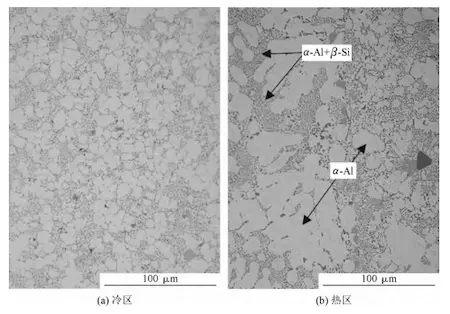
(a) Spheroidized Si(b) Intermetallic compounds
Figure 1 Microstructure of as-cast AlSi10MMg alloy
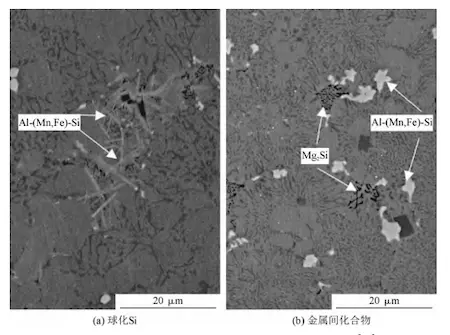
Figure 2 SEM images of heat-treated AISi10MnMg alloy

(a) Spheroidized Si(b) Intermetallic compounds
Figure 1 Microstructure of as-cast AlSi10MMg alloy

Figure 2 SEM images of heat-treated AISi10MnMg alloy
2.2.2 AISi8, AlSi9
The Si content in the AISi8 and AISi9 series aluminum alloys is low, allowing them to achieve higher strength while maintaining 10% elongation. Theoretically, their fluidity falls between AISi7 and AISi10. This makes it an ideal material system for large-scale integrated die casting, frequently used in low-pressure casting technology (Figure 3). Figure 3 shows the microstructure of the independently developed HT22(AISi9MnMg). Compared to AISi10MnMg, the α-Al structure in the AISi9MnMg alloy accounts for a higher proportion, contributing to better toughness, and the Si phase in the eutectic structure exhibits greater refinement.
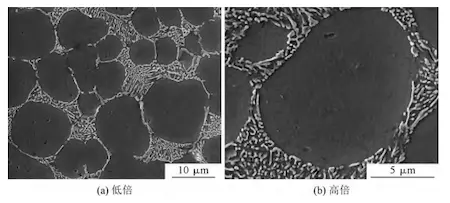
Figure 3 As-cast AlSi9MnMg alloy

Figure 3 As-cast AlSi9MnMg alloy
2.2.3 AISi7 Series
The representative alloy of the AlSi7 series is C611, and its Si content is typically controlled between 6.5% and 7.5%. The chemical composition is similar to the A356 aluminum alloy, with the primary difference being the addition of Mn, which makes it more suitable for die-casting demolding. The solidification range of the AISi7 (Mg) series aluminum alloy is relatively wide. Initially, it did not receive much attention in the field of integrated die-casting technology. However, it has been extensively studied in the field of semi-solid die casting. Currently, C611 has the advantages of a simple composition and high toughness, and its application is becoming increasingly widespread. Figure 4 shows the FESEM and EDX spectra of A356 composite materials reinforced with 0.3% graphene nanosheets (GNPs). In the AlSi7 material, Al is the main element and is continuously distributed throughout the phase structure. The area of the α-Al phase is significantly larger than that in AISi8–AISi10 system materials, the proportion of the eutectic structure is small, and it exhibits good plasticity.
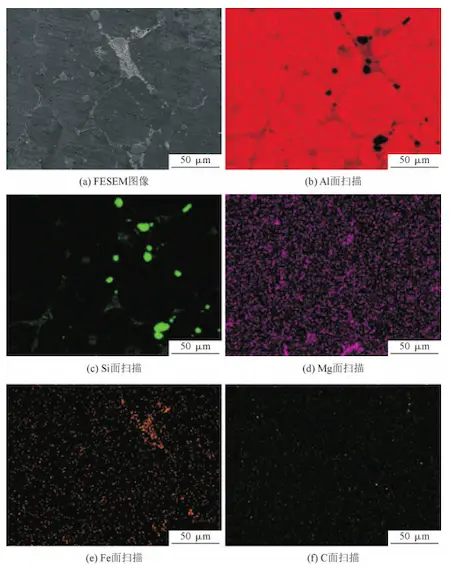
(a) FESEM image (b) AI surface scan (c) Si scan (d) Ng scan (e) Fe surface scan (f) C surface scan
Figure 4 FESEM-EDX elemental mapping of thixoformed A356 composite reinforced with 0.3% GNPs

(a) FESEM image (b) AI surface scan (c) Si scan (d) Ng scan (e) Fe surface scan (f) C surface scan
Figure 4 FESEM-EDX elemental mapping of thixoformed A356 composite reinforced with 0.3% GNPs
2.2.4 AIMg5 System
Magsimal-59 is a representative material of the Al-Mg system cast aluminum alloy, with similar chemical properties. The morphology of AlMg5Si2Mn is shown in Figure 5. Compared with ordinary AlMg5 series, the β phases in the eutectic structure of Magsimal-59 are very fine, which is the key to the high mechanical properties and ductility of the cast Magsimal-59. Currently, Al-Mg series alloys are almost exclusively used for metal mold casting.
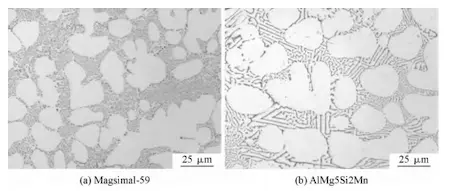
(a) Low magnification (b) High magnification
Figure 5 Microstructure of Magsimal-59 and AlMg5Si2Mn alloy

(a) Low magnification (b) High magnification
Figure 5 Microstructure of Magsimal-59 and AlMg5Si2Mn alloy
2.2.5 AIMg7 Series
JDA2b alloy is a representative alloy of the Al-Mg series materials. The nominal composition of the alloy is AlMg7Si3. It has a high Mg content and contains 45%–55% of the ternary eutectic structure, which is beneficial for improving the alloy's casting performance and shrinkage compensation during solidification, giving the alloy excellent casting properties. The Mgratio in the eutectic structure is fine, showing micron-level and submicron-level rod-shaped and spherical morphological characteristics, as shown in Figure 6.
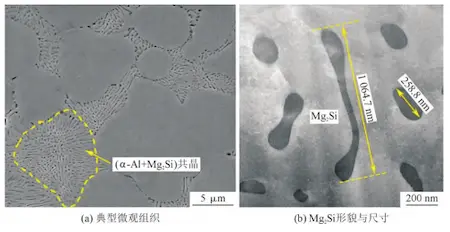
(a) Typical microstructure (b) Mg.Si morphology and size
Figure 6 Phase morphologies of JDA 2b alloy

(a) Typical microstructure (b) Mg.Si morphology and size
Figure 6 Phase morphologies of JDA 2b alloy
Related News
- Industrialization of the Composite 3D Printing for General Motors
- Porsche and GM Have Obtained Achievement in 3D Printing Auto Parts Technology
- Development of Aluminum Alloy Die Castings for Automobile Steering Knuckles (Part Two)
- Development of Aluminum Alloy Die Castings for Automobile Steering Knuckles (Part One)
- Die Casting Technologies of Automobile Structural Parts (Part Three)
- The Die Casting Technology of Automobile Structural Parts (Part Two)
- The Die Casting Technology of Automobile Structural Parts (Part One)
- Application of Heat-Free Aluminum Alloys to Integrated Die-Casting
- Mechanical Properties and Microstructure of Heat-Free Alloys
- Designing Die-Cast Molds for Complex Shells


